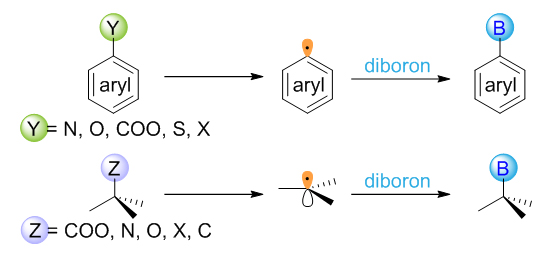摘要/Abstract

有机硼酸和硼酸酯化合物是以Suzuki-Miyaura偶联为代表的多种重要化学反应的底物.发展有机硼化合物的高效合成方法具有重要意义.近十年来,基于自由基机理的有机硼酯化反应得以发展,并迅速成为高效构建碳硼键的一类重要方法.自由基硼酯化反应的一般策略为:利用不同反应条件产生的碳自由基活泼中间体与联硼化合物反应,生成相应的有机硼酸或硼酸酯.本文根据反应产生的碳自由基种类的不同,将硼酯化反应分为基于芳基自由基和基于烷基自由基两大部分.各部分依据自由基前体种类的不同,又具体分为基于碳氮、碳氧、碳卤等化学键的硼酯化反应以及羧酸脱羧硼酯化反应.最后,我们进一步总结分析了未来自由基硼酯化反应的研究趋势.
关键词: 自由基化学, 硼酯化反应, 联硼化合物, 芳基自由基, 烷基自由基
Organoboronic acids and esters are highly valuable building blocks in cross-coupling reactions and practical intermediates of various functional group transformations. Additionally, organoboronic acids can be utilized directly as small molecule drugs. Therefore, development of efficient methods to synthesize organoboronic compounds is of significant importance. Traditional pathways to synthesize organoboronic compounds mainly rely on electrophilic borylation of organometallic reagent and transition-metal-catalyzed borylation. Radical intermediates have unique chemical properties which are quite different from those of polar intermediates resulted from the heterolysis of chemical bonds and those of the organometallic compounds during transition metal catalysis. As such, borylation based on radical mechanism possesses distinctive reaction process, substrate scope, reaction selectivity, etc., and have great potential in synthesis of organoboronic compounds. In 2010, the Wang's group first reported borylation via a radical mechanism. This method realized an efficient direct conversion of anilines into aryl organoboronic esters. Inspired by this innovative work, more and more borylation methods via radical intermediates have been reported and developed as new avenues for C-B bond formation in the past decade. A series of studies show that organoboronic acids and esters could be efficiently constructed by the reaction of aryl/alkyl radicals with diboron compounds. In this paper, we summarize the recent development of borylation reactions via radical mechanisms, including aryl and alkyl radical borylation. As for aryl radical borylation, the activation of substrates containing C-N, C-O, C-S, C-X (X=halogen) bonds and carboxylic acids to C-B bond is summarized respectively. As for alkyl radical borylation, the activation of substrates containing C-N, C-O, C-X (X=halogen), C-C bonds and carboxylic acids to C-B bond is summarized respectively. Finally, we provide a perspective on the future development direction of this research area.
Key words: radical chemistry, borylation reaction, diboron compounds, aryl radical, alkyl radical
PDF全文下载地址:
点我下载PDF
